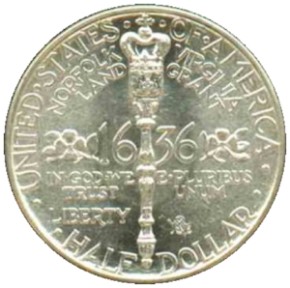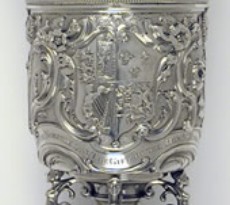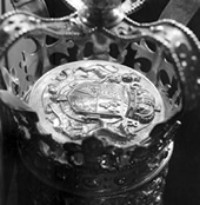
About Andrew Cusack
 Writer, web designer, etc.; born in New York; educated in Argentina, Scotland, and South Africa; now based in London.
Writer, web designer, etc.; born in New York; educated in Argentina, Scotland, and South Africa; now based in London. read more
News
Blogs
Reviews & Periodicals
Arts & Design
World
France
Mitteleuropa
Knickerbockers
Argentina
The Levant
Africa
Cape of Good Hope
Netherlands
Scandinavia
Québec
India
Muscovy
Germany
Academica
A 250-Year-Old Mace in the Old Dominion
 THE MACE OF the City of Norfolk in the Commonwealth of Virginia is believed to be the oldest civic mace in any of the United States still in use by the city for which it was made. Robert Dinwiddie, the Lieutenant Governor and Commander-in-Chief of the Dominion of Virginia, commissioned the English silversmith Fuller White to make the silver and wood mace for the City of Norfolk, at the time the largest town in the crown colony. The inscription around the base of the bowl of the Mace denotes the generous donation:
THE MACE OF the City of Norfolk in the Commonwealth of Virginia is believed to be the oldest civic mace in any of the United States still in use by the city for which it was made. Robert Dinwiddie, the Lieutenant Governor and Commander-in-Chief of the Dominion of Virginia, commissioned the English silversmith Fuller White to make the silver and wood mace for the City of Norfolk, at the time the largest town in the crown colony. The inscription around the base of the bowl of the Mace denotes the generous donation:
Despite the inscription of 1753, the mace took some time to reach the shores of America, and the minutes of the Norfolk council record the actual presentation:
Fuller White built the mace of eleven interlocking pieces of sterling silver weighing 104 ounces, which centered around a wooden rod. The Norfolk mace measures forty-one-and-a-half inches long from the very bottom of the base to the apex of the crown.
The Royal Arms, depicted in three places on the mace, most prominently outside the bowl and inside the base of the crown, are those of George II, Britain’s second German king known for his poor grasp of the English language.
In several places on the mace are depicted national emblems of George’s realm: the English rose, the Scottish thistle, the Irish harp, and the fleur-de-lis representing the claim to the throne of France still maintained — at least heraldically — at the time.
As was the given custom, the mace preceded the mayor in the public processions of Norfolk after its arrival, and by custom an outgoing mayor would present the mace to the incoming man to symbolize the transfer of authority.
During the Revolution, the City of Norfolk remained loyal, and most of the inhabitants thereof evacuated the city before it was occupied by North Carolinian rebels. John Murray, the 4th Earl Dunmore and Governor of Virginia at the time, bombarded Norfolk on January 1, 1776. The physical city did not survive the fire from the bombardment combined with the looting by rebel troops which proceded, though it arose as a phoenix after the violence had ceased. The mace, however, had been evacuated with the loyal denizens to Kempe’s Landing (now Kempesville) and so survived.

The mace was featured in this 1936 half-dollar coin commemorating the Norfolk land grant of 1636.
The first recorded appearance of the Norfolk mace after the great disruption in the natural government of the land was its presence in a parade held on July 4, 1788 celebrating Virginia’s ratification of the new Constitution. Proposals made in 1794 and 1836 to rid the mace of its royal symbolism thankfully came to naught. The latter year marked the 150th anniversary of Norfolk’s royal charter, and that document was paraded together with the mace through the streets of the city. The 250th anniversary of Virginia was recalled with the mace’s presence at the Jamestown commemorations on May 13, 1857.
In 1952, two sterling silver replicas of the mace were made by Sam Rubenstein of the Keystone Silver Company. One was given to the Norfolk City Council for everday use, preventing additional wear and tear on the original mace, while the second was donated to the Chrysler Museum of Art for display. In 1989, the original colonial mace presented to the Borough of Norfolk in 1754 found its current home next to the 1952 replica at the Chrysler Museum of Art, where it rests to this day.


The Royal Arms on the civic mace of Norfolk, Virginia.
Search
Instagram: @andcusack
Click here for my Instagram photos.Most Recent Posts
- Sag Harbor Cinema March 26, 2025
- Teutonic Takeover March 10, 2025
- Katalin Bánffy-Jelen, R.I.P. March 3, 2025
- Substack Cusackiensis March 3, 2025
- In the Courts of the Lord February 13, 2025
Most Recent Comments
Book Wishlist
Monthly Archives
Categories



The mace was last used ( as far as I know ) for ceremonial purposes at Jamestown, Va. during the 250th (?) anniversary celebration. The event and order of procession was written up and printed in one of the historical magazines. I found it while doing research about it but have misplaced my file.Do you have that information?
Thought you might like to see this latest picture of the Norfolk, Virginia Mace – During Prince Phillips visit tot Norfolk of Friday, May 4,2007.
http://www.tiny.cc/AAFgr
(look on the next to bottom row towards the right)
Stacye
Are there any listings on President Abraham Lincoln’s ‘canes’ given to American Indian Chiefs as symbols of recognized U.S.authority ?
Reihold Beuer-Tajovsky